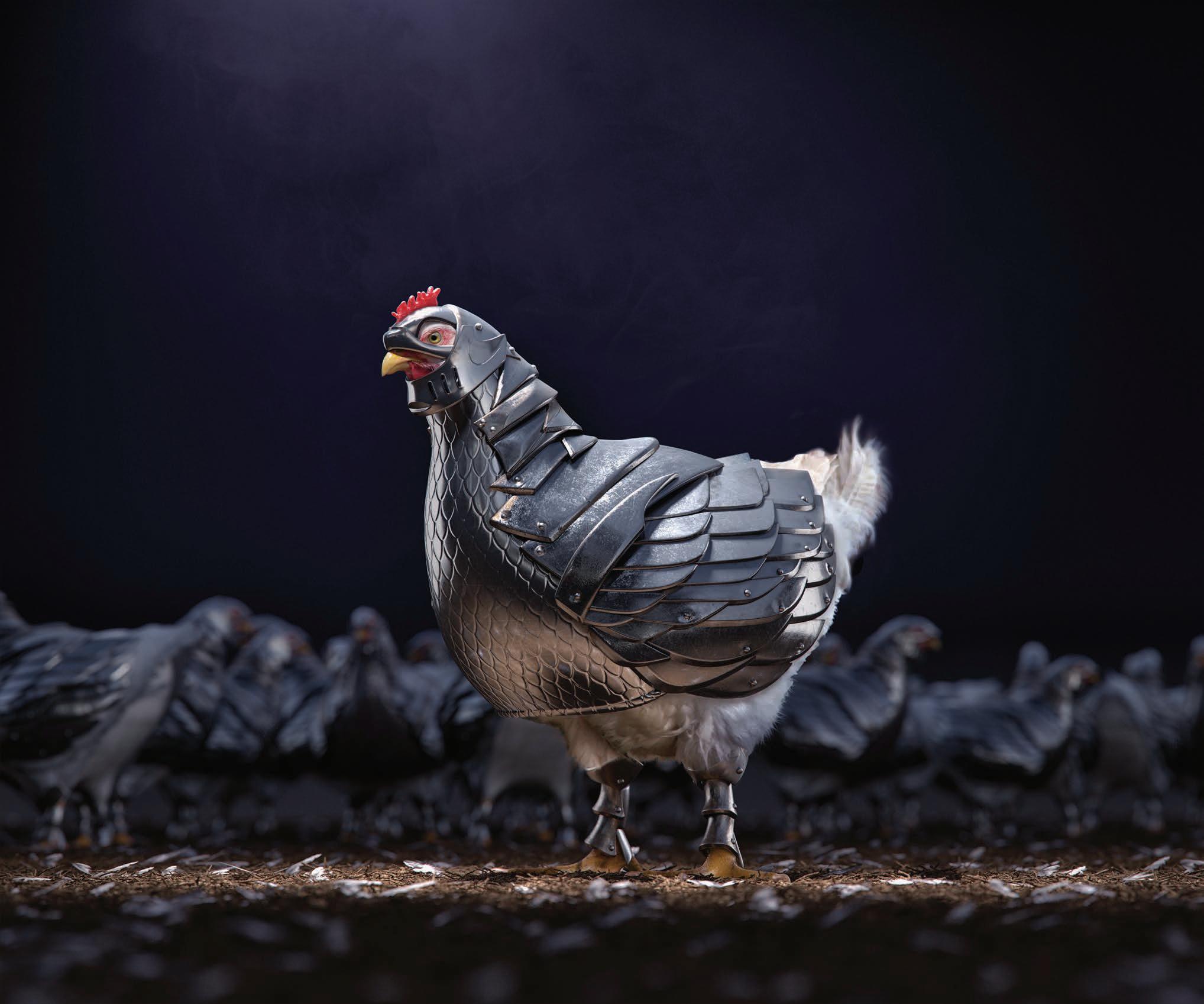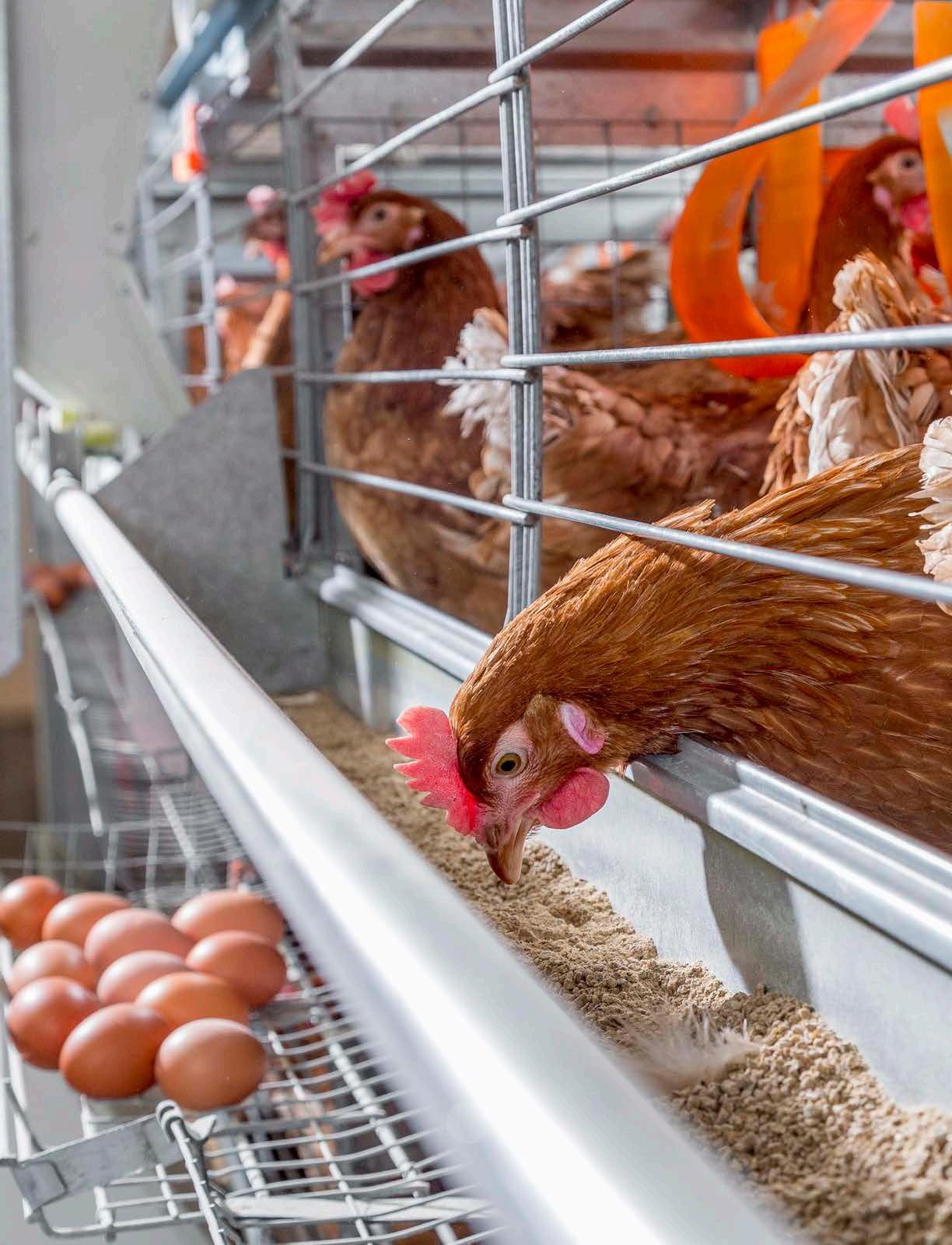




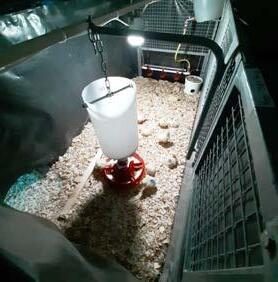

From the Editor
by Brett Ruffell








by Brett Ruffell
As one of the most feed-efficient protein sectors, poultry has always stood at the forefront of innovation. Yet as the challenges of cost, sustainability, welfare and consumer demand grow sharper, the role of nutrition in shaping the future of the industry has never been more vital.
This month’s issue of Canadian Poultry puts feed and nutrition in the spotlight. From novel ingredients to management tools that extend bird health and performance, the research and real-world applications featured here reflect the energy and creativity driving Canadian poultry forward.
“The role of nutrition in shaping the future of the industry has never been more vital.”
On page 10, we highlight a cross-country lineup of researchers testing new feedstuffs – from Alberta-grown faba beans to ahiflower oilseed, hempseed byproducts, and black soldier fly larvae meal. These alternative ingredients promise to cut costs, reduce imports and lower environmental impacts while adding functional value for birds and consumers alike.
Turning to layers, our cover story on page 14 explores the bold new goal of keeping hens productive for
up to 100 weeks. With advances in genetics making longer cycles possible, Canadian researchers are digging into the nutritional support needed to keep shells strong, livers healthy and bones resilient well past the traditional 72-week mark. If realized, this shift could mean as many as 500 eggs per hen – a win for both profitability and sustainability.
Nutrition’s role in environmental stewardship also takes centre stage on page 22, where Laval researcher Marie-Pierre Létourneau-Montminy is re-thinking the link between feed and manure. By fine-tuning mineral use, her work shows how precision feeding can make manure a better fit for crops – reducing waste and improving sustainability across the food system.
Of course, feed is only one part of the picture. On page 18, phytogenics demonstrate the growing value of plant-based functional additives, while on page 20, dynamic lighting trials and farm experiences reveal how thoughtful barn environments can complement nutrition by reducing stress and improving welfare.
Together, these stories illustrate an industry that continues to adapt and innovate. By looking closely at what and how we feed – and how that intersects with welfare and sustainability – Canadian poultry producers are ensuring the sector remains resilient, competitive and ready for the future.
canadianpoultrymag.com
Reader Service
Print and digital subscription inquiries or changes, please contact
Angelita Potal, Customer Service Rep.
Tel: (416) 510-5113
Email: apotal@annexbusinessmedia.com
Mail: 111 Gordon Baker Rd., Suite 400, Toronto, ON M2H 3R1
Editor Brett Ruffell bruffell@annexbusinessmedia.com 226-971-2133
Brand Sales Manager
Ross Anderson
randerson@annexbusinessmedia.com Cell: 289-925-7565
Account Coordinator
Julie Montgomery
jmontgomery@annexbusinessmedia.com 416-510-5163
Media Designer
Brooke Shaw
Group Publisher
Michelle Bertholet mbertholet@annexbusinessmedia.com
Audience Development Manager
Anita Madden amadden@annexbusinessmedia.com 416-510-5183
CEO Scott Jamieson sjamieson@annexbusinessmedia.com
PUBLICATION MAIL AGREEMENT #40065710
Printed in Canada ISSN 1703-2911
Subscription Rates
Canada - Single-copy $10.00
Canada – 1 Year $33.15
Canada – 2 years $56.61
Canada – 3 years $78.54 (plus applicable taxes)
USA – 1 Year $93.33 CDN
Foreign – 1 Year $105.57 CDN
GST - #867172652RT0001
Occasionally, Canadian Poultry Magazine will mail information on behalf of industry-related groups whose products and services we believe may be of interest to you. If you prefer not to receive this information, please contact our circulation department in any of the four ways listed above.
Annex Privacy Officer
privacy@annexbusinessmedia.com Tel: 800-668-2374
No part of the editorial content of this publication may be reprinted without the publisher’s written permission. ©2025Annex Business Media. All rights reserved. Opinions expressed in this magazine are not necessarily those of the editor or the publisher. No liability is assumed for errors or omissions. All advertising is subject to the publisher’s approval. Such approval does not imply any endorsement of the products or services advertised. Publisher reserves the right to refuse advertising that does not meet the standards of the publication.


After several months without new detections, avian influenza has resurfaced in Canadian commercial poultry flocks this September. Alberta confirmed multiple outbreaks, while Quebec reported its first case since January at a duck farm in the Eastern Townships. The resurgence follows a summer lull, with the last confirmed case prior to this month occurring in early May. Officials warn that fall migration increases the risk of further spread and emphasize strict biosecurity.
Egg Farmers of Canada (EFC) unveils its new Eggs Everywhere marketing campaign to inspire Canadians with easy, fun meal and snack ideas featuring eggs. Developed with Rethink, the campaign runs through 2026 and includes TV, digital, billboard, transit ads, a pop-up sampling event, and influencer engagement via #EggsAnytime. EFC says the playful campaign builds on the award-winning Eggs Anytime strategy, showing how versatile and convenient eggs can be for any meal.
Elite Farm Services has expanded into Manitoba through an agreement with Unity Catchers, taking over poultry services operations previously managed by the local company.
Existing crews and commitments will continue without disruption, while Elite brings added resources and expertise.
Unity will retain a stake in the Manitoba operations. With operations in British Columbia, Alberta, and Saskatchewan, the expansion strengthens Elite Farm Services’ role as a leading poultry service provider in Western Canada.

Dr. Karen Schwean-Lardner, a professor at the University of Saskatchewan, has been honoured with Animal Health Canada’s Farm Animal Welfare Leadership Award.
is approximately how many broilers benefit each year from Dr. Karen Schwean-Lardner’s welfare research.
A globally respected scientist and educator, her research has transformed poultry welfare practices in Canada and around the world. Her work on the management of meat-type birds has improved the welfare of an estimated 30 billion broilers annually, according to Dr. Frank Robinson, Professor Emeritus at the University of Alberta.
Beyond her research, Schwean-Lardner has played an influential role in shaping Canadian livestock policy and practice. She has advised leading food companies, contributed to several Codes of Practice for the care and handling of farm animals, and served as President of the Poultry Science Association.
Her academic contributions
include more than 80 peer-reviewed papers and over 100 industry presentations, sharing science-based knowledge with both producers and policymakers. Teaching and mentorship have been hallmarks of her career. Schwean-Lardner has guided numerous graduate and undergraduate students, many of whom now hold leadership positions in animal agriculture. Her classroom excellence earned multiple honours, including the 2025 North American Colleges and Teachers of Agriculture Educator Award.
“Her work has improved the lives of billions of animals, informed national policy, empowered producers, and inspired the next generation of animal welfare leaders,” says Dr. Natacha Hogan, Professor at the University of Saskatchewan.
The award was presented during Animal Health Canada’s annual Forum in Ottawa.
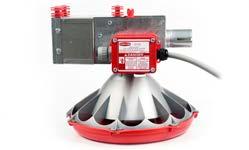
Chore-Time’s new SignalPro Universal Control Pan features a universal mount compatible with most systems. An integrated LED light attracts birds, boosting feeding activity at the line’s start. The result is improved intake, better feed flow, consistent distribution, healthier birds and stronger overall flock performance.
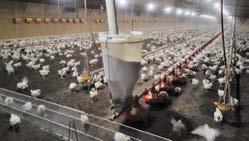
Cumberland’s new plastic feed line hoppers combine strength and flexibility in a compact design. Offered in 100- and 150-pound sizes, they’re lightweight, easy to install or retrofit, and built with reinforced bottoms and thick sidewalls. Quick pin detachment and line brackets simplify maintenance, ensuring consistent feed flow.

Increased turnover and efficiency are key factors for the success of the LANDMECO customers in the broiler farming industry all over the world. The patented pan feeding solution for broilers increases growth rate and makes it more homogeneous and more efficient. With the unique design of the pan the chicks will learn correct feeding
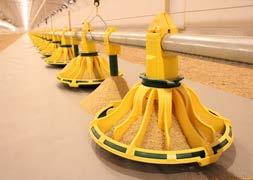
Valco’s FUZE V feeder delivers efficient, humane feeding with a high flood setting for young birds and a low feed-saver lip to reduce waste without limiting access. Easy cleaning improves overall sanitation and lowers disease risk, while reliable feed delivery supports consistent growth and maximum efficiency.
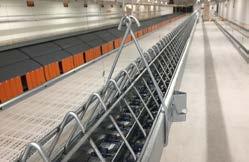
Big Dutchman’s DuoChain is a straight-line chain feeding system for roosters or hens. A center-divided trough moves feed in both directions for fast, even distribution with less stress. Flexible standing or suspended mounting eases installation, while the open design supports inspection, cleaning, durability and long barn runs.
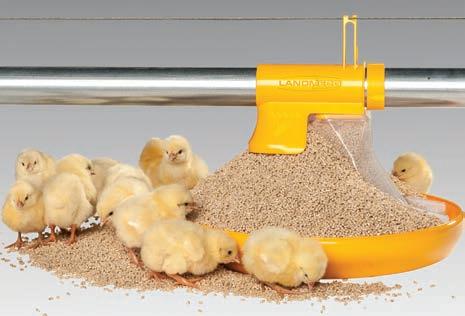
behaviour from day one and the chicks will grow faster, hitting their target weight in less time, which makes the whole operation more profitable for you. The patented solutions from LANDMECO also secures an optimization of the performance and operational reliability through simple robust designs.
An optimal production in broiler farming requires that the equipment is modern, efficient and easy to use — and ours is. At the end of the day you can trust us to install a barn for you which is much more profitable, and which makes your daily operation much easier.
Contact sales@county-line.ca
800-463-7622 (Hickson ext 4) www.county-line.ca
Listowel
8582 Hwy 23 N., Listowel ON Hickson 596202 Highway 59, Woodstock, ON

+ 30 G THE FIRST WEEK! The system stimulates the chicks’ curiosity and collectively activates them to seek fresh feed. Experiments have thus shown that chick bodyweight is up to 30 g higher than normal after the first week when the Kick-Off 330° system is used.
By Jane Robinson
Marie-Pierre Létourneau-Montminy didn’t grow up in agriculture, but she’s knee deep in finding ways to reduce the environmental footprint of manure by managing key minerals in poultry and swine diets. She’s particularly interested in making manure better. “If we don’t manage manure properly, it has a very significant environmental impact,” she says. “We have developed nutritional strategies to reduce phosphorus and nitrogen excretion in manure, and now we need to optimize the composition of the manure in terms of these two nutrients.”
After completing her PhD from AgroParisTech and Laval University on calcium and phosphorus metabolism in weaner pigs and broilers, Létourneau-Montminy joined Laval as an associate professor in agriculture and food science. Since 2020, she has held a Canada Research Chair Tier 2 on Sustainable Animal Protein Production.
Through her research and collaborations, she is making significant contributions to mineral nutrition. Blending basic and applied research lets her tackle practical problems with opportunities for producers and nutritionists. “I am really interested in the challenges farmers are facing so I can fit the science to answer their concerns,” she says.
When it comes to sustainable animal protein production, Létourneau-Montminy is digging into ways for poultry production to have a low environmental impact, encourage the responsible use of antibiotics and use feed
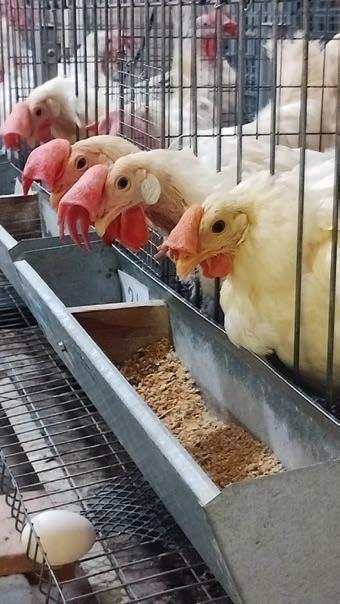
ingredients not consumed by people.
With estimates that feed makes up about 50 per cent of the environmental impact of poultry production, Létourneau-Montminy believes the industry needs a more system-driven approach to sustainability. “We need more collaboration between crop science, soil science and animal science,” she says.
“The idea of connecting manure as fertilizer to feeding strategies is pretty new, so it will take some changes.”
That’s where precision feeding comes in – the ability to predict daily requirements and provide just what the animal needs. “Precision feeding can be challenging in poultry but we are working on following animal growth more precisely so we can minimize the loss of nutrients in manure and reduce the potential environmental impact.”
She’s using precision feeding strategies to
design manure that is a better fit for what crops require and is especially interested in using modelling to predict the amount of phosphorus and nitrogen retained by poultry for production, and the amount excreted in manure.
Létourneau-Montminy knows how important collaboration is with colleagues, industry and farmers. She first experienced the value of grassroots input during her PhD that was partially funded through industry. “I really try to keep connections with farmers.”
With much of her work involving feed formulations, it doesn’t hurt that Laval research farm doesn’t include a feed mill, giving Létourneau-Montminy another important touchpoint to work directly with local feed mills on formulations.
“In Canada, the foundation of research is tightly linked to industry, so I work to keep in touch with what our research is about –trying to answer their questions and stay connected.”
On a bigger scale, Létourneau-Montminy keeps close ties with other researchers. “All my projects are done in collaboration with international colleagues, especially in France, Switzerland and the U.S.,” she says. “It’s important to share knowledge on minerals because there are not a lot of us working in this area.”
Sustainable protein production is also about feeding a growing population. With global meat production expected to double by 2050, poultry will play a key role in providing high-quality protein worldwide. Létourneau-Montminy advances this work internationally as director of LIA NUTRI-MOD, which develops precision-feeding recommendations to save resources, reduce waste and support productivity, health and welfare. “Most of my research is focused on the environment,” she says, “but also on maintaining Canada’s competitiveness.”

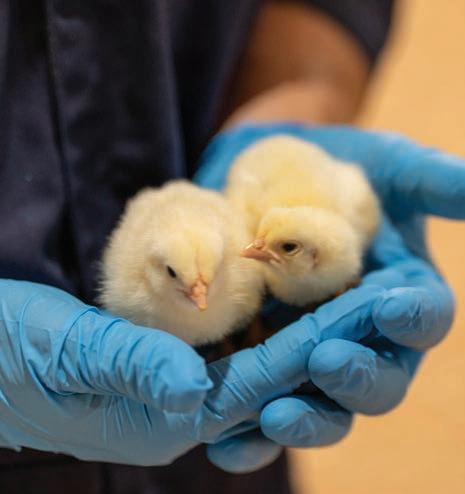
By Jane Robinson
Feed costs eat up about 70 per cent of production costs on Canadian poultry farms. Poultry researchers are searching for innovative alternatives that support bird health, productivity and profitability. We asked researchers across Canada about some of the interesting feed ingredients on the horizon.
Matt Oryschak believes adding faba beans to poultry feed is a farmready innovation. The pulse crop is grown in Alberta and Saskatchewan, and research has suggested its potential as a feedstuff for layers and broilers.
“Faba beans could reduce the industry’s reliance on imported soybean meal while simultaneously reducing the greenhouse gas footprint of production,” says Oryschak, a PhD student at the University of Alberta with Doug Korver. “They have the lowest greenhouse gas emission intensity of any pulse crop grown in Canada.”
Oryschak thinks the crop offers a triple win for agriculture – a protein and energy dense option for poultry diets, a low environmental footprint, and the opportunity for great self-sufficiency. His research focused on generating information needed to facilitate greater use of faba beans in layer and broiler feeding programs.
He’s still analyzing some of the results, but his project has generated encouraging findings. Including faba beans in layer diets at 36 per cent and in broiler diets at 48 per cent had no adverse effect on productivity or product quality. At these inclusion levels, faba beans replaced soybean meal completely in layer diets and from 60 to 80 per cent in broiler diets. Adding faba beans to both layer and broiler diets reduced the greenhouse gas intensity associated with feed by 20 to 25 per cent. Importantly, tannins in faba beans do not appear to impact palatability.
Faba beans are an approved feed ingredient in Canada. “The biggest obstacle for increasing the use of faba beans in poultry
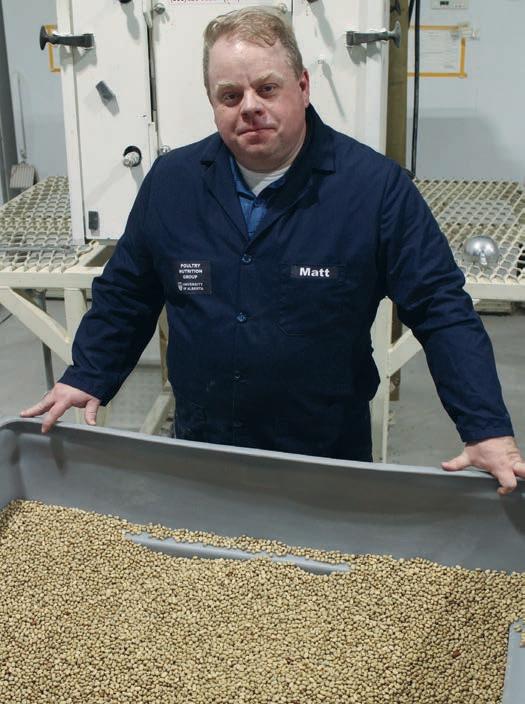
production is that there simply isn’t enough to ensure a stable supply for the feed sector,” says Oryschak.
“I would really like to get poultry and pulse producers talking about cross-sectoral opportunities.”
Deborah Adewole is always looking for novel ingredients to help reduce the cost of feed for poultry producers and drive sustainability. Her latest research has added in the functional food angle of poultry feed ingredients.
“There’s increased interest in functional foods that provide health benefits in addition to their nutritional value,” says Adewole,
assistant professor, nonruminant nutrition and metabolism at the University of Saskatchewan. “Omega 3 eggs are a good example, and we went searching for novel oilseeds as a way to enrich table eggs.”
The search led them to ahiflower – an oilseed crop grown mostly in the UK – and a processing facility in PEI. Ahiflower seeds are crushed to produce oil and a “waste” byproduct called press cake that contains some seed oil as well as protein and energy.
They found that ahiflower is a rich, alternative source of essential fatty acids that can be utilized in poultry diets to enrich table eggs.
“Ahiflower oil contains up to 20 times more stearidonic acid than flax, canola and soybeans,” says Adewole. “This fatty acid is important in human nutrition because it is converted more efficiently to usable forms that support brain and eye development, reduce cardiovascular disease risk and reduce inflammation.”
To dig deeper into the possibilities of using ahiflower to pass benefits from birds to egg consumers, Adewole and her MSc student (and now research technician) Roseline Ogory fed different levels of ahiflower seed and press cake to laying hens of various ages.
The biggest opportunity they uncovered was adding 10 per cent ahiflower seeds to layer diets to produce eggs that are an excellent source of omega 3 fatty acids in eggs. The seed and press cake can also be used to replace some of the corn, soybean meal and limestone in diets to potentially reduce the cost of production. In broilers, they are measuring omega 3 levels in the meat that may result from including ahiflower seed and press cake in the feed.
“The press cake is considered waste, so if we can use it for animal feed it could supply energy, protein, and particularly calcium and phosphorus to reduce costs for producers and improve sustainability for poultry production,” says Adewole.
Ahiflower is not approved as a feed ingredient for poultry in Canada, but the researcher has the data needed to pursue this approval with the Canadian Feed Inspection Agency (CFIA).
Black soldier fly larvae meal
Jing Lu thinks of black soldier flies as nature’s superheroes. “They are phenomenal composters, transforming organic waste into quality protein to provide a sustainable feed ingredient and reduce waste that would otherwise end up in landfills,” says
Lu, who recently completed her PhD at Dalhousie University with Stephanie Collins – who’s been researching black soldier fly larvae meal (BSFLM) in layer diets for more than five years.
BSFLM is an economical, alternative protein that can replace some of the corn













At Chore-Time, we go to the ends of the earth to serve our customers. That means we work hard to provide you with the right poultry system. It means we deliver innovative solutions for your speci c challenges. And it means we literally have a physical presence nearby to support you...no matter where you are in the world.



and soybean content in layer diets and is generated in a carbon negative environment. The ingredient also shows great promise as a sustainable protein source with gut health potential and addresses a growing consumer demand for food produced with minimal environmental impact.
Lu and Collins have found that when BSFLM is included as 6.5 per cent of the diet – or 13 per cent when fed with protease (an enzyme to support protein digestibility) – there are measurable shifts to the gut microbiome. But there is still work to do.
“If we can develop a process to help make the protein more available, we’ll achieve a win-win with higher protein availability for the birds and nutrients that promote beneficial gut microbes,” says Lu.
BSFLM is an approved feed ingredient in Canada, but widespread commercial production is still limited.
Lu is also looking at the potential for green tea and seaweed polyphenols – ingredients rich in antioxidants – as early-life alternatives to in-feed antibiotics for broilers.
The compounds are delivered to the embryo before hatch (in ovo) to see if they could provide lasting benefits to the gut microbiome.
“Our early results have shown that a single dose of seaweed polyphenols delivered in ovo reduced the level of Clostridium bacteria linked to necrotic enteritis, similar to birds having an in-feed antibiotic treatment,” says Lu. They also noted this route of administration did not affect hatchability or growth.
Hempseed byproducts pack a powerhouse of nutritional possibilities for laying hens. Similar to ahiflower, the oil and press cake (byproduct of oil extraction) are being
“By testing new feed ingredients, we’re helping producers remain competitive and supporting more resilient and sustainable food systems.”
- Jessica Gill
evaluated for the ability to do double duty – provide nutritional benefits for hens and functional benefits for consumers.
Hempseed contains about 25 per cent protein and is rich in omega 3 and omega 6 fatty acids, according to Jessica Gill, who recently completed her MSc in poultry nutrition with Stephanie Collins at Dalhousie University.
“The healthy fat profile from hempseed can enrich the nutritional quality of eggs and the protein supports growth and maintenance for the bird,” says Gill, who now works at Trouw Nutrition Canada. “Hemp contains trace amounts of cannabinoids like CBD that may help reduce stress and provide a calming effect for the birds.”
What’s more, hemp comes with antioxidant and anti-inflammatory properties that could help reduce the incidence of fatty liver disease.
Gill’s MSc research looked at the use of hempseed byproducts in layer diets and potential effects on fatty liver disease, feather pecking, bone strength and egg enrichment.
Hempseed press cake and oil was used at varying levels in white and brown hens housed in conventional cages and single tier systems.
“Adding hempseed byproducts to layer diets enhanced the omega 3 and omega 6 content of eggs without transferring cannabinoids to the eggs or breast tissue,” says Gill. “There were no negative effects on egg quality, yolks were lighter and redder in colour, and birds had stronger tibia strength that could reduce fracture loss later in lay.”
Hempseed press cake and oil could provide a cost-effective, Canadian-grown alternative protein and fat source for producers that reduces agricultural waste and creates a new market opportunity for local hemp growers.
“By testing new feed ingredients, we’re helping producers remain competitive and supporting more resilient and sustainable food systems,” says Gill.
Hempseed is not currently approved for use in poultry diets in Canada, but Gill’s research has contributed to an application that is under review by CFIA.

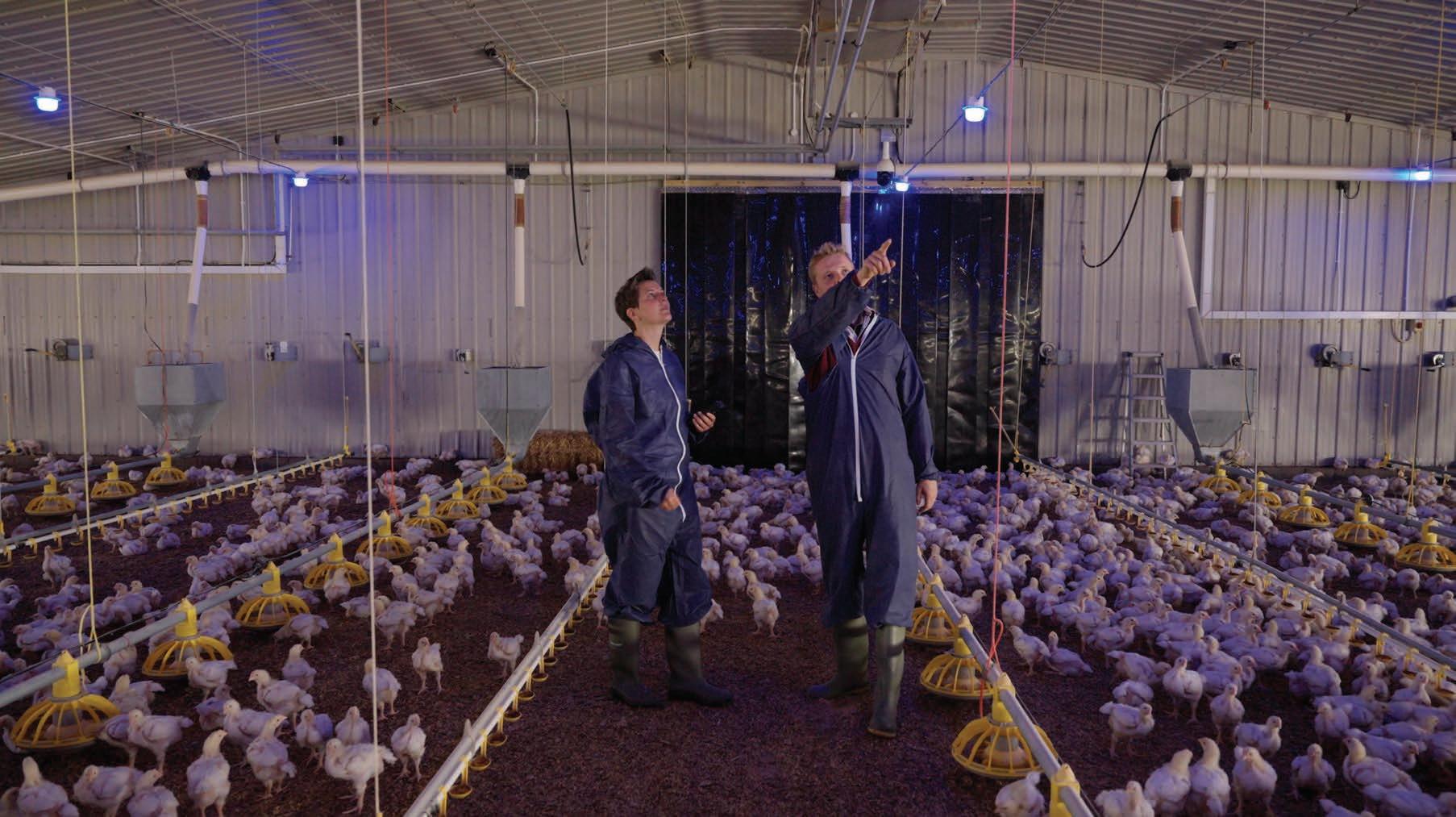

Experience the future of animal farming with NatureDynamics, a cutting-edge, wirelessly controlled lighting system designed to enhance animal welfare and boost productivity.
Tailored for poultry, swine, and aquatic species, NatureDynamics allows you to adjust light spectrum and intensity throughout the day and production cycle using scientifically developed light recipes.
These recipes, grounded in extensive research, optimize animal growth and well-being.
Embrace a smarter, more efficient approach to animal lighting and see the difference.
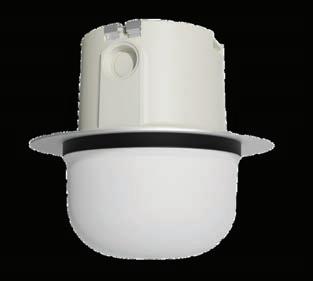
NATUREDYNAMICS DOME
SMART + CONNECTED LIGHTING THAT MANAGES YOUR FLOCK THROUGH LIGHT RECIPES
SAMPLE LIGHT RECIPES
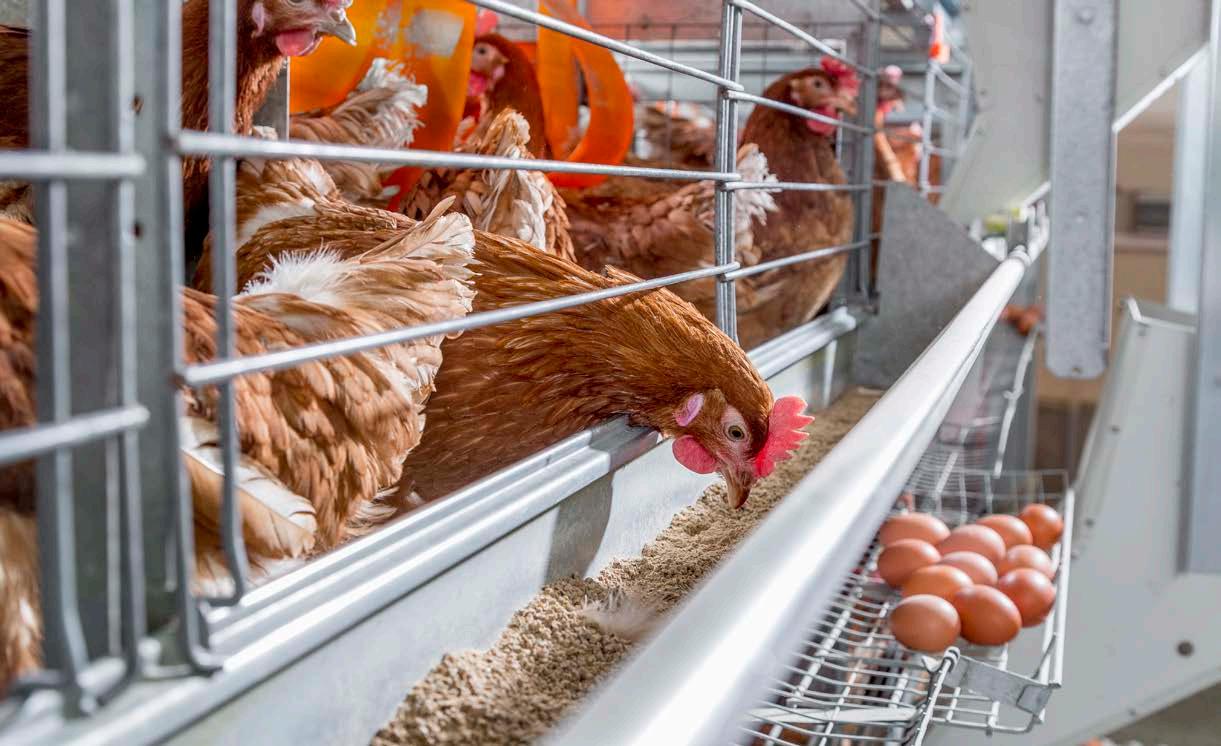
By Jane Robinson
Advances in poultry genetics make it possible for hens to continue laying for up to 100 weeks of age. The prospect for upping lifetime egg production does come with downsides to bird health and performance – something researchers in Canada are working vigilantly to address.
Extending egg production by about 28 weeks could return up to 500 eggs per bird, boosting productivity and profitability for producers. But egg production is a complex process with many factors impacting a longer, productive life for laying hens, and there is little information available for what layers need beyond 72 weeks.
“If we can get more eggs per bird then we have a way to increase food security and profitability for producers,” says Elijah Kiarie, who holds the McIntosh Family Professorship in Poultry Nutrition at the University of Guelph. His research explores nutritional strategies to support longer egg
production without compromising egg quality and liveability for layers.
“We are trying to understand what the hen needs for an extended lay and think ahead with practical applications that producers may be able to use in the future,” says Kiarie.
While genetic progress may make a productive life possible for layers beyond 72 weeks, the risks to older hens include the challenge to control egg weight, a decline eggshell quality and the ability to absorb calcium, and an increased risk of fatty liver hemorrhagic syndrome and osteoporosis.
Controlling egg weight is key to keeping hens longer and often involves reducing protein in the diet, that can in turn increase the diet’s energy concentration and consumption. The source of energy in a hen’s diet has enormous implications on the accumulation of fat in the liver.
“The liver is an important organ when it
comes to keeping hens longer, so we need to understand it better and how to manage it for bird health, longevity and productivity,” says Kiarie. His PhD student Lonita Manoa is looking at a few different additives in the hen’s diet that could support a healthier, longer lay period.
As a nutritionist, Manoa is interested in taking care of all the organs, hormones and tissues involved in egg production, so birds can produce more, high quality eggs. “My research is looking at changing the source of energy in the diet by reducing the amount of starch from cereal grains and replacing it with fibre,” says Manoa. “Fibre is a source of energy that’s available when fed with an enzyme to help make the fibre more accessible to the bird.”
One of her research trials involves adding fibre and exogenous enzyme to layer diets from 72 weeks to 100 weeks of age, and measuring key performance indicators in-
Crack open the future of poultry, egg, feed and meat innovation! From game-changing tech to global networking, this is where ideas hatch and you discover thousands of innovations for your business directed at bird health, housing, logistics, packaging and more.
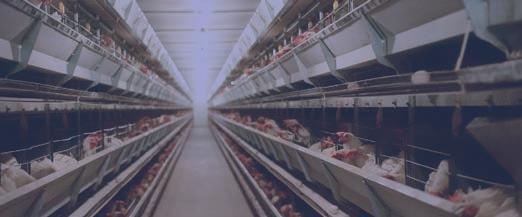
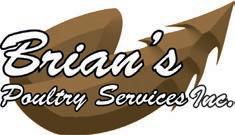
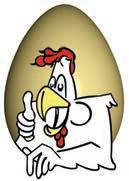
We are excited to announce that Brian’s Poultry Services has acquired Diane Edwards’ crew. You will continue to see the same familiar faces of their workers, now complemented by the addition of our own, to form a fully functional and equipped crew. Our Brian’s Poultry crews have been doing a great job with the layer work, and a few of those workers will be incorporated into Diane’s crew located in Strathroy. Don and Henry will continue to supervise. We are committed to providing the best services from both Diane’s and Brian’s Poultry.
To book any size layer vaccinations, pullet and layer moves, please contact Zach Weber at scheduling@brianspoultry.com or call 1-888-292-2249.

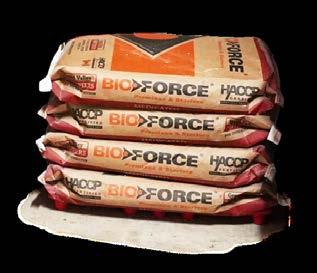

cluding egg production, egg quality and liver condition through scoring.
She’s still evaluating the results, but the early findings look positive for these ingredients that are already approved for use in Canada.
Manoa’s second trial is with fruit pomace – a waste product of the food processing industry that includes seeds and skins with natural antioxidants. Pomace is bulky and has to be refined to produce a very small quantity that contains the bioactive portion. There are commercially available pomace-based feed ingredients in Canada, but most are sourced from outside Canada, according to Kiarie.
In older hens, pomace may help improve the hen’s total antioxidant capacity and be able to control hemorrhages that come with fatty liver syndrome.
Manoa is sourcing local pomace from cranberry, grape, apple and blueberries with an eye to the practicality needed down the road if these ingredients could nutritionally support a longer lay period. This feeding trial will get underway within the year and will add varying levels of pomace to layer diets at about 18 weeks of age, to measure key production factors as well as incidence of fatty liver.
“I am hoping to see that the antioxidants will help older hens maintain egg production and quality, and prolong livability without impacting their welfare,” says Manoa. “We are looking for a boost to flock productivity by supporting older hens, and also the ability to waste (pomace) into a sustainable food ingredient.”
At Laval University, Marie-Pierre Létourneau-Montminy has been focusing on the role of minerals in supporting a longer laying period. “If we are able to extend the lay period and ensure birds remain healthy and maintain egg quality, we can use fewer birds to produce more eggs. And as dietary protein is reduced with age, there will be less nitrogen excretion,” says Létourneau-Montminy, who holds the Canada Research Chair in Sustainable Animal Protein Production.
Calcium and phosphorus are deposited together in bone – calcium goes to the eggshell and excess phosphorus is excreted in urine. But with little information available for inclusion levels in diets for older hens, Létourneau-Montminy’s feeding trials used recommended dietary levels of both minerals with hens from 70 to 100 weeks. The project is still underway but there are some surprising results that are adding to the knowledge being built around a sustainable longer lay period.
Hens maintained a laying rate of more than 85 per cent at 100 weeks of age. “These birds are very resilient,” says Létourneau-Montminy.
Bone mineral content was not lost from the bones of the laying hens before 100 weeks of age. “We expected mineral levels in the bone to be depleted during an extended lay period, but surprisingly, that didn’t happen,” she says. These results suggest the recommended calcium and phosphorus levels through the normal lay period are adequate to support an extended lay.
Phosphorus levels can be reduced during the normal lay period with no impact on bird performance or health, but maintaining full levels during an extended lay period may be important. “It’s possible to reduce phosphorus by about 25 per cent without affecting hen performance up to about 75 weeks,” says Létourneau-Montminy. “But during an extended lay period, we are seeing that it may be best to not decrease phosphorus because of the role it may play in helping hens manage stress.”
For egg producers, production goals focus on lay persistency, egg size and shell quality. But the prospect of extending the lay period – and the environmental and profitability benefits – will require the development of a broader life-cycle approach, and integrating the nutrition and management of breeder-pullet-hen will be critical.
“Our work is a bit hypothetical at this point because producers have to deflock at 72 weeks,” says Kiarie. “But a bird built on longevity and production would represent an exciting new shift and opportunity for Canadian poultry producers, and we want to figure out what it would take for this potential game changer to take hold.”

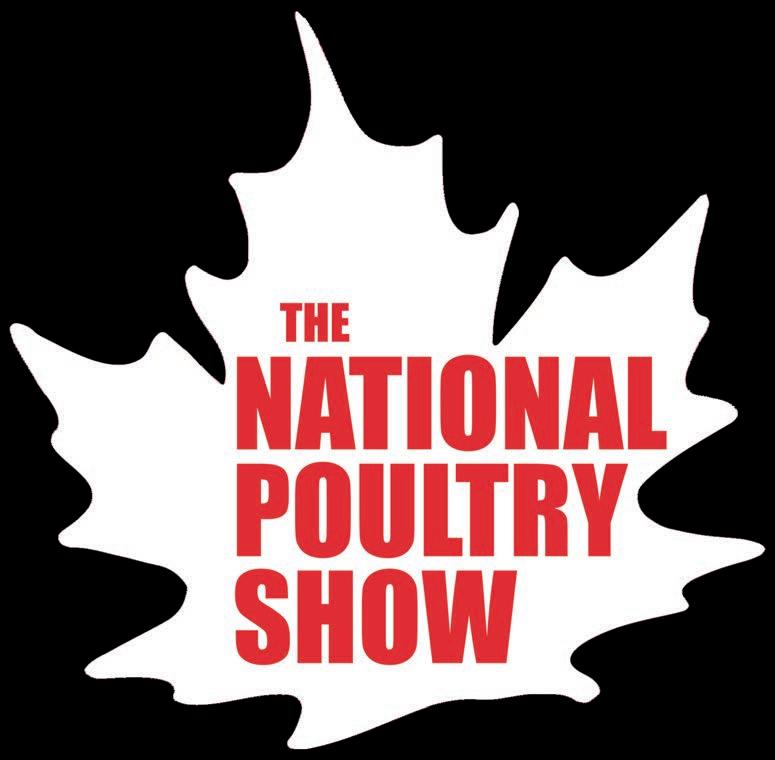



Phytogenics are gaining
ground as functional feed additives – but knowing how they work and when to use them is key to unlocking their potential.
By Lauren Dawson
In Canada and around the world, the poultry industry is undergoing transformation, driven by evolving consumer expectations, regulatory pressures, and the growing demand for sustainable production practices.
Within this landscape, phytogenics have emerged as a promising innovation in animal nutrition.
These plant-derived feed additives are becoming increasingly popular, with an ever-expanding range of products on the market. With so many options available, it’s important for poultry producers to understand what phytogenics are, how they work, and when they can bring the most value; this knowledge is key to making informed, profitable decisions.
The term ‘phytogenic’ means ‘derived from plants’. In animal nutrition, phytogenics are feed additives that contain bioactive components derived from plants that can
be used to improve animal performance and health. Examples of plants that have been used in livestock feed include oregano, capsicum, cinnamon, and turmeric.
Although they are often discussed as alternatives to antibiotics, phytogenics do not target microbes directly at typical inclusion levels. Instead, these novel, plant-based functional ingredients act on the host animal, with the potential to alter the animal’s physiology, metabolism, or nutrient absorption. When phytogenic compounds are provided in the right combinations and at the right dosages, they can support birds in reaching their full potential.
The gastrointestinal tract has a large surface area and is important for digestion. Scientists have realized that it acts as much more than a digestive organ. Research published in 2013 described the gut as a sensory organ that can detect and process messages from its environment
through receptors located on the intestinal cells facing the inner space of the gut.
The molecules in an animal’s diet can interact with these receptors to target, desensitize or block certain signals. The signals initiate a chain of adjustments within the animal’s body, which can impact processes like metabolism, immunity, hormone secretion, or inflammation. As a result, including these molecules in an animal’s diet can ultimately impact their health and performance.
Choosing the most effective phytogenic solution requires understanding the source, form, and mode of action.
One of the most critical distinctions is between natural and synthetic forms of phytogenics.
Natural phytogenics are extracted directly from plant materials through processes such as steam distillation, solvent extraction, or maceration. These extracts
often contain a complex mixture of active compounds, which can work synergistically to influence many physiological pathways. This complexity can enhance bioactivity in animals, even at lower inclusion levels. The combination of different products and their associated bioactives is termed a phytocomplex.
In contrast, synthetic phytogenics are lab-produced versions of individual plant metabolites, such as pure carvacrol (from oregano) or thymol (from thyme). While these offer high purity and standardization, they lack the supporting compounds found in natural extracts. In other words, they are missing the other elements that are included alongside the natural version. This can limit their functional range and reduce their ability to interact with the animal in a nuanced way. For example, studies have shown that natural forms of artemisinin can have higher bioavailability and efficacy compared to synthetic versions, underscoring the importance of providing the full plant matrix.
The opportunity in poultry production
Innovations in phytogenic feed additives present poultry producers with new tools to enhance performance. For example, our internal research trials have investigated different phytocomplexes to see which mixes, doses, and stages can bring the most benefit. In a recent broiler trial in which the birds were fed a diet with reduced antibiotics (coccidiostat), one phytogenic mix showed promising results on performance with respect to body weight gain, feed conversion, and economic performance.
With all phytogenics, the key is to match the right product to your flock’s needs, goals, and management system. Your nutritionist is your best resource for navigating the various available phytogenic additives. With an understanding of both the science and your specific on-farm situation, they can help you select the best solutions for your operation.
Lauren Dawson, PhD, is monogastric brand manager with Trouw Nutrition North America.
PulsFOG® disinfecting and pest control

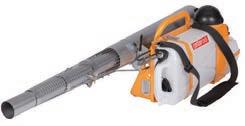
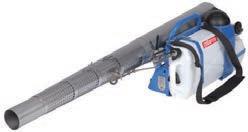
The fog generated by PulsFOG will cover all hard to reach areas. Assortment of PulsFOG models to choose from.


Results show broilers thrive when they choose their own light.
By Melanie Epp
Broiler barns that mix bright and dark zones see calmer birds and fewer losses, according to some producers. Their observations corroborate studies from Wageningen University & Research scientist
Ingrid de Jong, which found when birds are allowed to choose their own light, performance holds and welfare signals improve.
In a recent interview, she described a simple management rule: build predictable places for activity and rest, then let the flock sort itself.
Birds show lighting preferences
De Jong’s research points to one consistent message: when broilers are offered a choice in lighting, they use it to manage their behaviour and comfort.
Across three studies, the researchers examined different light gradients, intensities and spectra.
“Our idea was that if you know what birds prefer, then you can adapt to conditions in such a way that they feel better and have improved welfare,” de Jong says.
In the first study, fast- (Ross 308) and slower-growing (Hubbard JA757) broilers were housed in pens offering 0.2, 20, 50 and 1,000 lux to test light-intensity preferences by age, time of day and behaviour. Both breeds were more active under brighter light and more inactive in dim
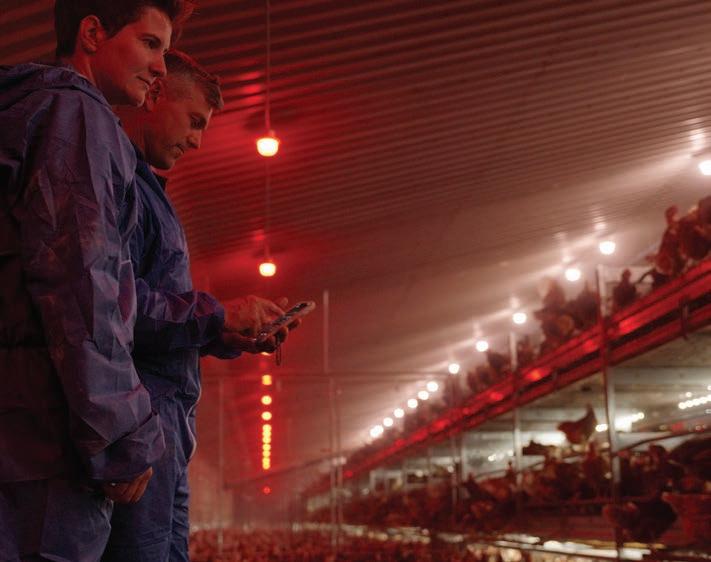
light. Chicks preferred brighter light when young and shifted to dimmer light with age, especially slower-growing birds (0.2 lux). All birds favoured brighter light at the start and end of the photoperiod. The study’s authors suggest using variable lighting to create functional zones and tailoring light programs to age, time of day and breed, noting birds were always present at every intensity, indicating individual preferences.
The second study used a four-compartment choice test (green vs sky-blue; 15 vs 100 lux) with fast-growing Ross 308 and Hubbard JA757 broilers, tracking where birds spent time, what they did, and how much they ate. Early on, birds preferred
bright green light, then bright sky-blue (weeks two–three), with no clear preference later. Slower-growing birds shifted to low-intensity light by weeks seven–eight. Activity and foraging were higher in brighter/green areas while inactivity was higher in dim/sky-blue.
Feed intake patterns mirrored this, supporting lighting programs that vary by age, breed, and time of day.
The third study tested broilers’ preferences for UV-A versus non-UV lighting from hatch to slaughter by giving Ross 308 and Hubbard JA757 birds free access to both light conditions and recording where they chose to be, what behaviours they performed, and how much feed they ate.
Birds showed a slight daytime preference for UV in early life. In the evening, slower-growing birds preferred UV in weeks one–four, but non-UV in weeks six–eight. Drinking was higher under UV, foraging was higher for slower-growing birds under non-UV, and feed intake was higher on the UV side in the starter phase for both breeds and in the finisher phase for Ross birds.
Taken together, the studies support dynamic, choice-based lighting, providing zones that vary in intensity, colour and UV and adjusting them by age, time of day and breed. “We did not find negative effects on growth or feed conversion, so you can still have the same performance, but with a better welfare situation,” de Jong says.
Manufacturers back nuanced approach
In line with de Jong’s research, ONCE by Signify says birds do best when lighting matches what they actually choose across age, behaviour and time of day.
The company offers two complementary systems: dynamic lighting that changes spectrum, intensity and photoperiod over time, and gradient lighting that varies those conditions across space to give birds real choice.
“We have a lighting system that’s fully customizable and programmable, where we can change intensity and spectrum over time,” says Aaron Stephan, research director at Signify. Using research-led “recipes” settings shift as broilers mature so they can eat and play under brighter light and rest in dimmer zones.
Those zones aren’t just created for comfort. Stephan says they help turn unavoidable stress into healthy “eustress” by letting birds solve it themselves.
“In a situation where we have uniform lighting, and we light up the whole barn bright, they can’t escape it… all the birds are shot to the wall,” Stephan says.
However, zoned, purposefully brighter areas near feeders and dimmer resting areas improve traffic flow and support natural behaviour. The company continues to fine-tune commercial programs in partnership with growers.
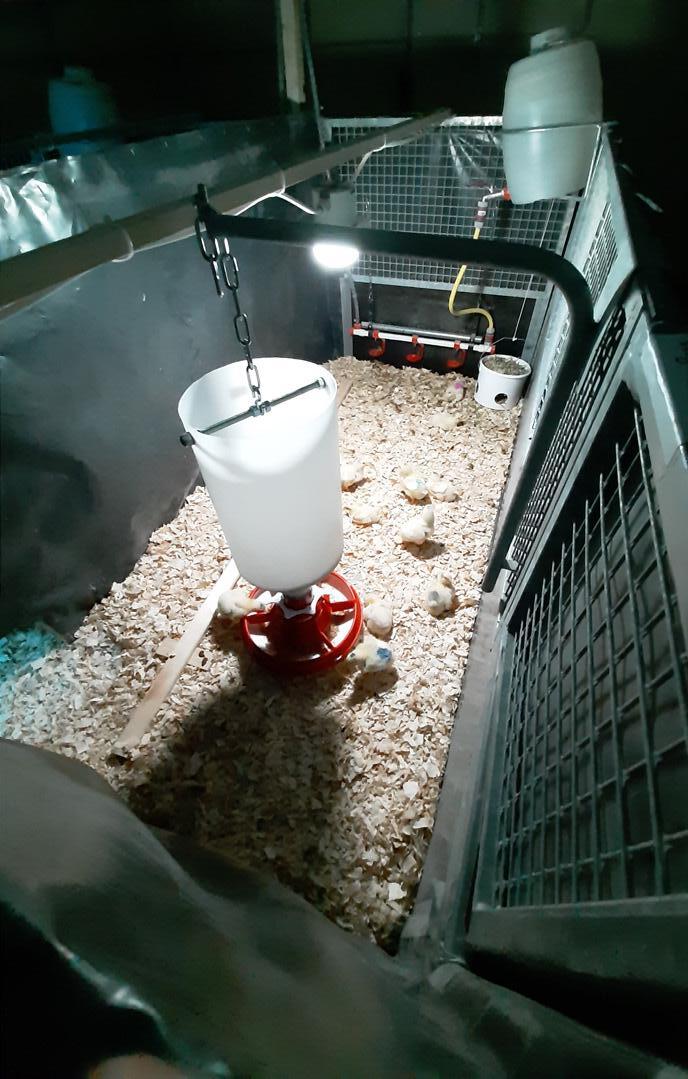
Two B.C. case studies
Chilliwack, B.C., grower Des Soumang raises 30,000–35,000 slow-growing Taiwanese Shon Don birds and runs ONCE by Signify’s dynamic lighting using the Junglite recipe, adopted at the end of 2022. He programs the spectrum, intensity and photoperiod – cycling greens, blues and reds – to keep a naturally flighty flock calm and steady.
He also uses a monochrome-blue setting
during catching or mid-cycle repairs so birds settle while staff can still see their work, which has supported noticeably calmer behaviour, roughly 0.5–1 per cent lower mortality and reduced utility use since switching to Junglite.
Fraser Valley, B.C., broiler farmer Jeffrey Spitters runs a mixed organic and specialty operation spanning roughly 42 barns across seven properties, cycling about 500,000 birds at a time that include Loong Kong, Hong Kong Goldens and silkies.
He adopted ONCE by Signify’s NatureDynamics system using the Junglite recipe in his newest houses, running a predominantly green-hued dynamic spectrum alongside natural daylight and an eighthour dark period each night.
Spitters reports calmer, more mobile flocks, his best feed conversion, lower mortality and a consistent weight advantage of roughly 0.1–0.2 kg per bird in Junglite barns compared with similar barns on standard LEDs. He’s seen even larger gains where barns were upgraded with sealed wall finishes.
He values the “set it and forget it” programming and says the system can be retrofitted when barns are renovated, and appreciates the productivity and welfare benefits he’s seen first-hand from adopting ONCE by Signify’s Junglite. Spitters plans to transition more of his barns in the future.
“I’m going to be putting those lights in because I know there’s a marked benefit to them,” he says.
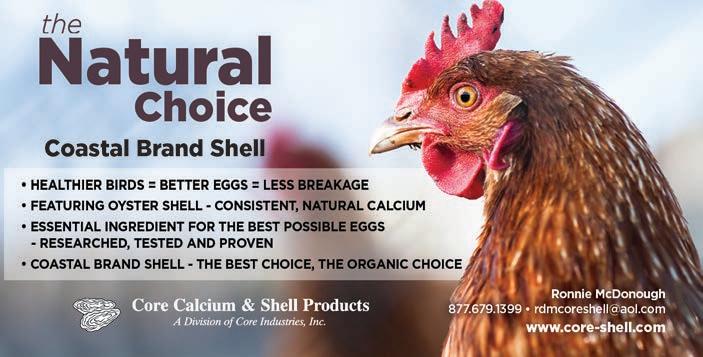

By Dr. Gigi Lin
Dr. Gigi Lin is a board-certified poultry veterinarian. She provides diagnostic, research, consultation, continuing education, and field services to all levels of the poultry industry in Western Canada. In this column, she will share case-based reviews of brooding best practices.
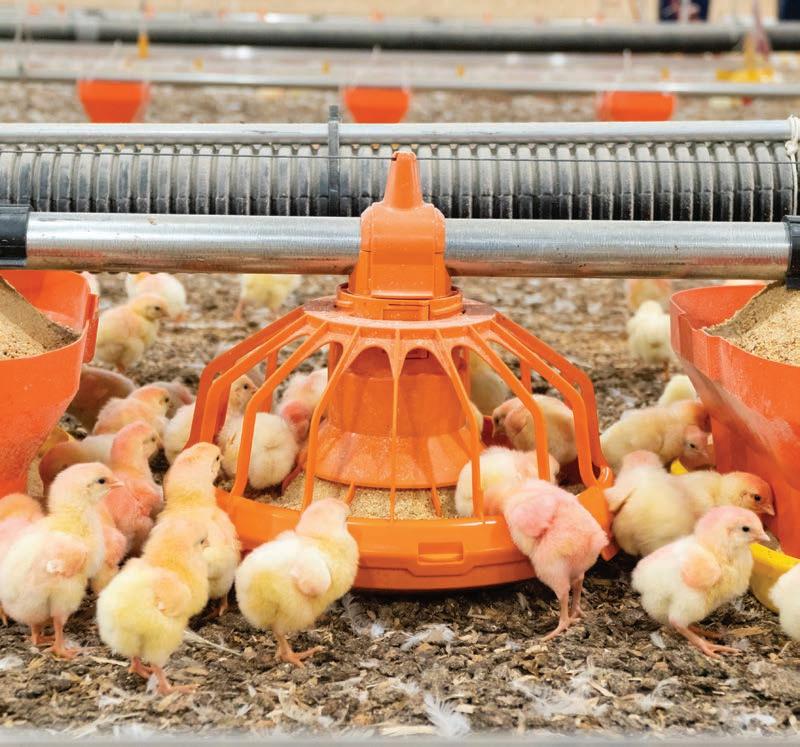
We are very fortunate that, with knowledgeable nutritional experts, dedicated research, and advanced technology, modern broilers are provided with diets that enable them to achieve their full genetic potential and performance. Because of this precision nutrition, significant primary nutritional issues such as formulation mistakes and mixing
errors are uncommon.
Secondary nutritional problems, however, are encountered more often. These do not arise because the feed itself is of suboptimal quality, but rather because birds are unable to access or properly absorb nutrients. As I have described in previous issues, such problems may result from feed system failures, environmental stressors, or disease compromising intake.
Although primary feed
issues are relatively rare, they can still occur and knowing how to address them promptly is key to minimizing flock impact. In this issue, I will present a case involving a true primary nutritional deficiency and highlight the collaborative approach that guided its investigation and resolution.
I received a phone call from a producer who had noticed
weak and limping chicks from his eight-day-old broiler flock. He reported that water consumption had dropped noticeably the day before, and several chicks appeared weaker and slower to move. Overnight, more birds developed an unsteady gait but most of them remained bright and alert.
The mortality rate was normal, but he had begun culling birds with severe mobility issues, so I asked him to bring me some live chicks with clinical signs for necropsy.
On clinical examination, the affected chicks were bright and alert and made attempts to walk, but were unable to do so. Some rested on their hocks, while others flapped their wings excessively to maintain balance. These birds were euthanized for postmortem examination.
The most striking findings were rubbery and easily bendable bones. All the chicks had soft beaks that could be bent with little pressure, and their legs were fragile and easily bendable. A few of the chicks had seemingly longer than normal growth plates on the drumstick, though this was subtle. I could not find any other visible lesion. The intestinal tracts appeared normal, with no evidence of coccidiosis or enteritis.
I collected bone tissues for histopathology to confirm the diagnosis and intestinal tissues to help rule out diseases such as malabsorption syndrome.
Based on the clinical presentations and gross findings, I was
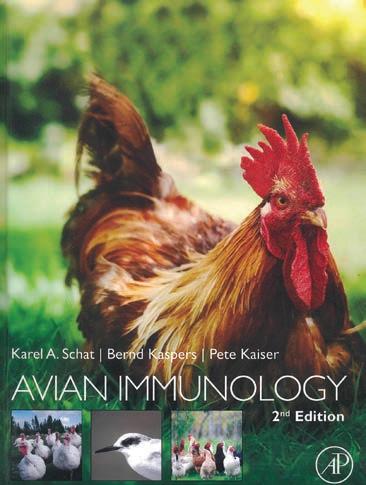

The second edition of Avian Immunology provides an up-to-date overview of the current knowledge of avian immunology. From the ontogeny of the avian immune system to practical application in vaccinology, the book encompasses all aspects of innate and adaptive immunity in chickens. In addition, chapters are devoted to the immunology of other commercially important species such as turkeys and ducks, and to ecoimmunology summarizing the knowledge of immune responses in free-living birds often in relation to reproductive success.
$230.50 | Item#0123969651
highly suspicious of rickets, since not many diseases present with pliable bones in young chicks. Rickets is a disease condition characterized by softening and weakening of growing bones due to impaired mineralization of bone and cartilage. This typically results from inadequate or imbalanced levels of calcium, phosphorus, or vitamin D.
Therefore, I contacted the feed supplier and discussed my suspicions with the poultry nutritionist right away, outlining my diagnostic approach to rule out other causes. At the same time, I recommended immediate feed replacement in case the problem originated from the feed.
The feed supplier was very cooperative. They delivered a new load of feed right away and sent their field technician to the farm to inspect the entire feed system and assess environmental conditions that might have hindered feed or water intake. Feed samples from both the
farm and supplier were submitted for nutritional analysis. In addition, we supplemented the flock with vitamin D 3 through the drinking water immediately while awaiting results.
The histopathology findings revealed mild thickening of the growth plate, but not to the severity that is typically seen in clear cases of rickets. There was no sign of intestinal diseases and no other abnormalities were found in the rest of the samples.
Although the lab result was not definitive, fortunately, we got the answer from the poultry nutritionist and confirmed that the feed analysis report revealed calcium levels at approximately one-third of the expected value, confirming rickets.
Following feed replacement and vitamin D 3 supplementa-
tion, we were relieved that clinical improvement was observed within several days. About three per cent of the severely affected chicks were culled, but morbidity did not continue to increase, and the remainder of the flock performed normally for the rest of the cycle.
Even though it was a feed mix error, the producer was particularly appreciative of the proactive response and transparent communication with the feed supplier.
This case stands out as one of the most positive I have worked on because it highlights the value of early diagnostic investigations and effective collaboration.
First, the producer was attentive to subtle changes in the flock. He noticed slowing activity and a slight decrease in water consumption the day before weakness became apparent, allowing immediate investigation.
The feed company was
equally proactive. Upon recognizing the high likelihood of rickets, they replaced the feed right away, submitted feed samples for analysis, and notified other clients who had received the same batch. The producer, together with the field technician, also thoroughly inspected the barn to rule out management deficiencies and evaluate the on-farm feed system.
Most importantly, the feed company shared the feed analysis report openly, confirmed that the calcium deficiency in the starter feed was the primary cause of the problem, and committed to an internal investigation to minimize future risk.
This case showcases the value of collaboration among the producer, poultry nutritionist, field technician and veterinarian, all working together to investigate the problem and implement corrective actions effectively, ultimately achieving a favourable outcome for the flock.






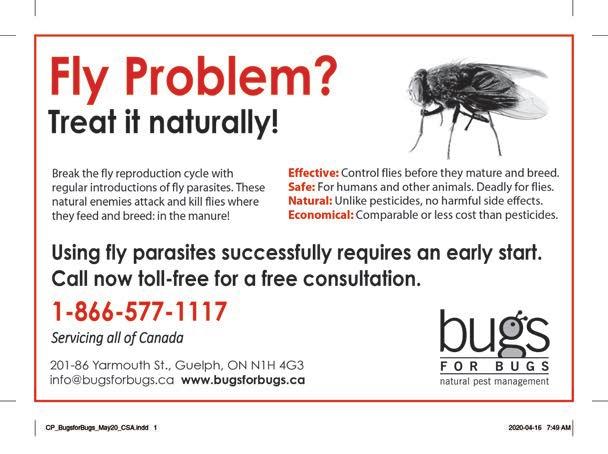






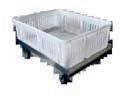
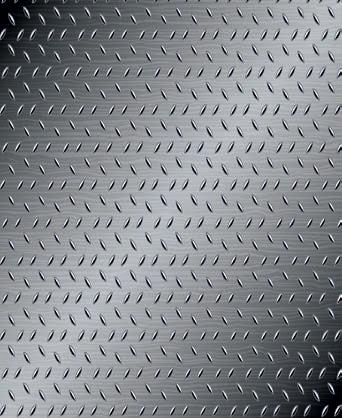



By Crystal Mackay
Poultry diets are formulated with so much expertise, science and precision. I marvel at how far poultry nutrition has progressed when I look back even just a few decades.
When speaking to people interested in learning more about farming, I have often said, “I wish I could eat even half as healthy as our chickens do with such balanced diets.”
We take great pride in feeding and caring for our chickens and turkeys with a continuous improvement mindset. What if we took even a percentage of that care and mindset and applied it to ourselves, our families, and our teams?
This isn’t going to be a human nutrition lesson – I’m not a dietitian. Instead, let’s focus on what feeds you: what motivates and keeps you positive and engaged at work and in life.
One important element to feeding your spirit is human connection. This may surprise you, as many in our industry choose to work with animals because they claim not to like people!
But people are hard-wired to need connection and a sense of belonging. This starts with our families and extends to our work teams.
Belonging and connection is in the middle of Maslow’s Hierarchy of Needs as published in 1943, directly after health, safety, food and water. So why does connection matter at work? According to the Gallup Global

Workplace Study (2024), over 20 per cent of people feel lonely at work, and the number is even higher among people under 35 and those who work from home.
The same study shows 50 per cent of people are disengaged at work. Disengaged employees do not meet expectations, get more sales or build good client relationships. At a time when our food system is already under-employed, we cannot afford to have half our workforce disengaged. So now we know ‘why’, let’s move to the ‘how’.
1Show up. The first step is to show up. Put yourself in places where you can meet people – attend events, farm shows, farm tours. Go to the hospitality suite. Take the bus tour. Show up early and talk to people.
2
Unique conversation. The second step is to introduce
yourself and have some unique conversation. This can and should include asking questions; it doesn’t have to be a soapbox of you doing all the talking! Be sure to share something you are positive about at work or in life. Find some common ground.
Fun fact: Science shows that if you share something positive with someone else, you increase their happiness and positive impression of you, as well as your happiness. Win-win-win.
3Make a micro-commitment. This is a small commitment to follow up and build on your initial connection. It can be as simple as a follow-up message or commenting on their social media. Invite them for a coffee or to meet you at an event you both might be attending.
These actions build your relationship without a big obligation and help you both get to know each other.
The above tips are for you to forge ahead when you’re on your own. Curious how to jump ahead many steps? Ask someone else to connect you. Do you have someone you know you could ask for ideas of who to meet?
Your credibility and connection will increase tenfold with an introduction from someone they already know and trust. Agriculture is a people business and relationships run deep.
Pro tip: If someone ever says “you should meet this person” – always say yes, even if you can’t see immediate value. Every person I’ve ever met on one of those recommendations has always turned out to be a golden connection.
While I have a long list of things you can do to feed your spirit, the best place to start is to connect. Show up and make it a priority with strategic intent. Do this, and the rest will come.
*Protection against GA08, GA13 and DMV/1639/11 IBV types.
A live monovalent bronchitis vaccine. Every droplet of Cevac IBron™ carries a tidal wave of protection against the DMV isolates of the avian infectious bronchitis virus. This live, monovalent bronchitis vaccine can be administered using coarse spray application or the gel spray route for rapid uptake.
Cevac IBron™ is the latest example of Ceva’s continual commitment to research and innovation, both today and in the future.
Contact your Ceva representative today to turn the tide on avian infectious bronchitis, with IBron™.
Tel: 800.510.8864 • service.canada@ceva.com • ceva-canada.ca


Reduce mortality
Reduce E. coli associated lesions
Potential to reduce antibiotic use
